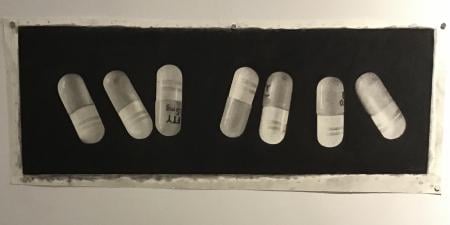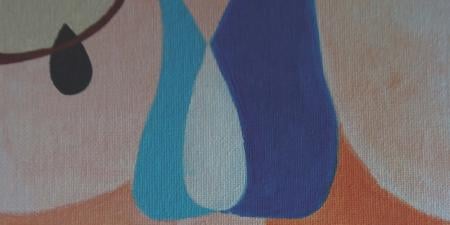Parallels
Imagine being confined and feeling trapped in your own house or apartment for months on end, afraid to leave the relative safety of your home because contact with other people could possibly bring you harm. Being isolated at home without an end in sight is no way to live. Fear, anxiety, depression, and even anger become your quarantine companions. During this past year, most of us can wholly grasp and empathize with this state of pandemic being.
Now consider living this way for a reason other than a pandemic: your hesitancy and trepidation about walking out the door is because some hate you enough to harm you … just because of how you look. What is worse than being a target yourself is conjuring up a worst-case scenario befalling your mother or elderly family member halfway across the country or college-age nephews and nieces living away from home for the first time. This inescapable torment is the current reality for many Asians, Asian Americans, and Asian-appearing people in this country.
Mob Murder
Resurgence of anti-Asian racism and xenophobia during the COVID-19 pandemic is not surprising. On October 24, 1871, one of the largest mob lynchings in US history—the “Chinese Massacre”—took place in Los Angeles. According to a 1999 Los Angeles Times account:
One by one, more victims were hauled from their hiding places, kicked, beaten, stabbed, shot and tortured by their captors. Some were dragged through the streets with ropes around their necks and hanged from a wooden awning over a sidewalk, a covered wagon or the crossbeam of a corral gate. Finally, 15 corpses—including those of a 14-year-old boy and the Chinese community’s only physician, Chee Long Tong—dangled in the City of the Angels. Four others died from gunshot wounds, bringing the death toll at the hands of the mob to 19—10% of the city’s tiny Chinese population.1
Not a Singular Incident
On March 16, 2021, a shooter targeted 3 Asian-owned businesses in the Atlanta area, killing 8 people, including 6 women of Asian descent, and raising the dark specter of misogyny and sexualized racism against Asian women.2 At a press briefing the day after the shooting, a sheriff spokesperson described the apparent hate crime as possibly reducible to a single errant guy who claimed to have a “sex addiction”—denying that the shootings had been racially motivated. The sheriff spokesperson described the shooter as being “pretty much fed up and kind of at the end of his rope. Yesterday was a really bad day for him and this is what he did.”3 Around the same time as this briefing, a 75-year-old Asian woman and grandmother was brutally assaulted in San Francisco, one among many unprovoked attacks across the country.4 Despite suffering multiple injuries, she insisted on donating the nearly $1 million raised to help with her medical bills and recovery to fight racism.4
Beyond these and countless other personal acts of racial terror, anti-Asian racism has long been institutionalized in this country—from the 1882 Chinese Exclusion Act,5 to internment of Japanese Americans during World War II,6 to racial profiling of South Asians after September 11th.7 These and many examples of transgenerational trauma suggest that, although a “lone wolf”8 commits a hate crime as an individual, it takes a society long-steeped in White supremacy and xenophobia to raise and nurture wolves. Given this country’s racist history, why is anti-Asian racism invisible to and denied by so many? Doing justice to the harms of anti-Asian racism’s invisibility is ambitious in a brief essay, yet I humbly offer the following.
Teachings
As a Chinese immigrant kid in Los Angeles during the 1970s, I was not formally taught the history of America’s anti-Asian racism, and I probably didn’t need to be, since I experienced it. After many years of divisive debate, the country’s most populous, diverse, and economically powerful state is moving forward with a K through 12 curriculum focused on the history and contributions of people of color, including Asian Americans, and the racism that we and so many have lived with.9 Given the plurality of stakeholders and their personal stakes in the telling of history, perfect consensus is likely impossible.10 Nevertheless, early childhood and preadult anti-racist education is necessary and should be widely integrated into civics and history curricula. That said, elected officials and educational leaders must guard against inadvertently creating competition among historically oppressed communities that focuses on shades of difference while masking shared bonds of suffering, since this tactic has traditionally been a tool of oppression. This divide-and-conquer strategy has long pitted people of color against each other, and another lived lesson of history is that White supremacy wins when those oppressed are fighting among themselves.
Pitting one oppressed racial or ethnic group against another is nothing new. People of Asian descent comprising more than 50 ethnicities and speaking over 100 languages11 have long been lumped together and labeled as a so-called “model minority.”12 This apparent monolithic accolade of Asian Americans’ achievements in higher education and the learned professions has also been well used as a racial wedge: if you just study and work harder, you, too, can succeed as a self-made American.13
This “model” label points to individual achievement, obscuring another overlooked social phenomenon: a bamboo ceiling whereby Asian Americans are looked upon as hardworking and industrious but not suited for leadership.14 It belies the reality that Asian Americans as a group have the highest income inequality15 and have had the highest percentage of long-term unemployed during the COVID-19 pandemic.16 It discounts the fact that Asian health care workers have been racially accosted even as they care for the sick17,18 and have died from COVID-19.19,20 That Asian Americans are held up as model citizens and then face attack as a nonhuman, threatening, virulent contagion in the seeming blink of an eye speaks to the insidiousness of anti-Asian racism.
Boats
Not rocking the boat is a behavioral stereotype of Asian Americans, and Hollywood would like you to see some truth in it.21 Fresh Off the Boat was a television sitcom featuring an Asian American immigrant family that premiered in 2015.22 Whether one considers the show’s “FOB” title to be a racial slur about Asian American immigrants’ or refugees’ unfamiliarity with the United States or something to make light of, this striking contradiction between the model minority and FOB stereotypes speaks to the complex transgenerational experiences of Asian families and their cultural values grounded in filial piety that tend to be oversimplified.23,24,25 Although there are Chinese and Japanese Americans who have family lineages dating farther back than some European Americans in this country, nearly 60% of Asians in America today were not born here.26
Asian refugees and immigrants who come to America to make a better life for themselves and their families will suffer, tolerate, and swallow a lot to make that dream happen. This quiet perseverance is passed on to the next generation, but, at this crucial moment of racial reckoning, such silence is deafening and deadly. With all due respect to our forebears, it is past time for Asian Americans as a community to shake up the ship of state and forge an alliance with all communities of color. We must exercise our power as consumers, workers, voters, and human beings to model and demand anti-racism as the new lifeboat of civilized society.
As an American who is proud of his Chinese heritage, I hope that our shared pandemic memories will engender greater empathy in more of us and that deeper social accountability for our common humanity will become more norm than news. History will be the judge.
References
-
Rasmussen C. A forgotten hero from a night of disgrace. Los Angeles Times. May 16, 1999. Accessed April 7, 2021. https://www.latimes.com/archives/la-xpm-1999-may-16-me-37851-story.html
-
Dewan S. How racism and sexism intertwine to torment Asian-American women. New York Times. March 18, 2021. Accessed April 7, 2021. https://www.nytimes.com/2021/03/18/us/racism-sexism-atlanta-spa-shooting.html
-
Kornfield M, Knowles H. Captain who said spa shootings suspect had “bad day” no longer a spokesman on case, official says. Washington Post. March 18, 2021. Accessed April 7, 2021. https://www.washingtonpost.com/nation/2021/03/17/jay-baker-bad-day/
-
Trent R. An Asian woman assaulted in San Francisco plans to donate almost $1 million to fight racism. CNN. March 25, 2021. Accessed April 7, 2021. https://www.cnn.com/2021/03/24/us/san-francisco-asian-woman-attacked-racism-donation-trnd/index.html
-
Burns R, Yu LS. The Chinese Exclusion Act. DVD. American Experience; 2018. Accessed April 7, 2021. https://www.pbs.org/wgbh/americanexperience/films/chinese-exclusion-act/
-
Japanese-American internment during World War II. National Archives. Reviewed March 17, 2020. Accessed April 7, 2021. https://www.archives.gov/education/lessons/japanese-relocation
- Ahmad MI. A rage shared by law: post-September 11 racial violence as crimes of passion. Calif Law Rev. 2004;92(5):1259-1330.
-
Cardoza N. Stop the “lone wolf” narrative. Anti-racism Daily. March 18, 2021. Accessed April 9, 20201. https://www.antiracismdaily.com/archives/stop-the-lone-wolf-narrative-anti-racism-daily
-
Agrawal N. California approves ethnic studies curriculum for K-12 schools after years of debate. Los Angeles Times. March 18, 2021. Accessed April 7, 2021. https://www.latimes.com/california/story/2021-03-18/ethnic-studies-finally-approved-california-schools
-
Times Editorial Board. California’s ethnic studies curriculum is controversial and a little sloppy—but much improved. Los Angeles Times. March 7, 2021. Accessed April 7, 2021. https://www.latimes.com/opinion/story/2021-03-07/californias-model-ethnic-studies-curriculum-is-controversial-a-little-slo
-
Office of Diversity and Inclusion, Johns Hopkins Medicine. National Asian Pacific Islander American Heritage Month. 2020. Accessed April 12, 2021. https://www.hopkinsmedicine.org/diversity/_documents/asian-american-pacific-islander-heritage-guide.pdf
-
McIlwain CD. The Routledge Companion to Race and Ethnicity. Routledge; 2010.
-
Chow K. “Model minority” myth again used as a racial wedge between Asians and Blacks. NPR. April 19, 2017. Accessed April 7, 2021. https://www.npr.org/sections/codeswitch/2017/04/19/524571669/model-minority-myth-again-used-as-a-racial-wedge-between-asians-and-blacks
-
Hyun J. Breaking the Bamboo Ceiling: Career Strategies for Asians. HarperCollins; 2005.
-
Kochhar R, Cilluffo A. Income inequality in the US is rising most rapidly among Asians. Pew Research Center. July 12, 2018. Accessed April 7, 2021. https://www.pewresearch.org/social-trends/2018/07/12/income-inequality-in-the-u-s-is-rising-most-rapidly-among-asians/
-
Bennett J. Long-term unemployment has risen sharply in US amid the pandemic, especially among Asian Americans. Fact Tank. March 11, 2021. Accessed April 7, 2021. https://www.pewresearch.org/fact-tank/2021/03/11/long-term-unemployment-has-risen-sharply-in-u-s-amid-the-pandemic-especially-among-asian-americans/
-
Jan T. Asian American doctors and nurses are fighting racism and the coronavirus. Washington Post. May 19, 2020. Accessed April 7, 2021. https://www.washingtonpost.com/business/2020/05/19/asian-american-discrimination/
-
Gerstmann E. Irony: hate crimes surge against Asian Americans while they are on the front lines fighting COVID-19. Forbes. April 4, 2020. Accessed April 7, 2021. https://www.forbes.com/sites/evangerstmann/2020/04/04/irony-hate-crimes-surge-against-asian-americans-while-they-are-on-the-front-lines-fighting-covid-19/?sh=24cfde9a3b70
-
Powell L. “It’s starting again”: why Filipino nurses dread the second wave. New York Times. January 15, 2021. Updated January 17, 2021. Accessed April 7, 2021. https://www.nytimes.com/2021/01/15/nyregion/filipino-nurses-coronavirus.html
-
Our key findings about US healthcare worker deaths in the pandemic’s first year. Guardian. April 8, 2021. Accessed April 9, 2021. https://www.theguardian.com/us-news/ng-interactive/2020/dec/22/lost-on-the-frontline-our-findings-to-date
-
Teng E. Why is it still okay to make fun of Asians? New Republic. March 16, 2016. https://newrepublic.com/article/131631/still-okay-make-fun-asians
-
Abad-Santos A. What “fresh off the boat” means to Asian-Americans. Vox. May 15, 2014. Accessed April 7, 2021. https://www.vox.com/2014/5/15/5717046/what-fresh-off-the-boat-means-to-asian-americans
-
Qian A. Analyzing Asian: the term “FOB” is a form of racism and we need to stop using it. Daily Trojan. February 20, 2019. Accessed April 7, 2021. https://dailytrojan.com/2019/02/20/analyzing-asian-the-term-fob-is-a-form-of-racism-and-we-need-to-stop-using-it/
- Lieber E, Nihira K, Mink IT. Filial piety, modernization, and the challenges of raising children for Chinese immigrants: quantitative and qualitative evidence. Ethos. 2004;32(3):324-347.
-
Bedford O, Yeh KH. The history and the future of the psychology of filial piety: Chinese norms to contextualized personality construct. Front Psychol. 2019;10:100.
-
Lopez G, Ruiz NG, Patten E. Key facts about Asian Americans, a diverse and growing population. Fact Tank. September 8, 2017. Accessed April 7, 2021. https://www.pewresearch.org/fact-tank/2017/09/08/key-facts-about-asian-americans/



